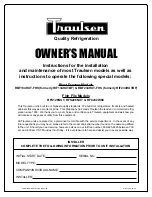
-7-
VIII. SPECIALTY PRODUCTS - BLAST FREEZER MODELS
VIII. a - BLAST FREEZER APPLICATION:
The roll-in blast freezer models were specifically de-
signed for batch processing, where quick freezing of
cooked product is required to help prolong shelf life.
VIII. b - SPECIAL INSTALLATION NOTE:
Installation should be performed as typical with any
other model, see
“
Section III.
”
However, a blast freezer
also requires provision of a floor drain for removing
condensate. A floor mounted electric condensate
evaporator is available from Traulsen as an optional
accessory.
Additionally, these models do not include a cord and
plug. Actual wiring to the power supply should be pro-
vided by a qualified electrician.
VIII. c - INTERIOR ARRANGEMENTS:
Traulsen blast freezers are designed to accommodate
27
”
wide by 29
”
deep by 66
”
high roll-in racks (mea-
surements with wheels inboard of frame). One sec-
tion model accommodates one (1) roll-in rack. Two
section model accommodates two (2) roll-in racks.
VIII. d - BLAST FREEZING vs. BLAST CHILLING:
The Traulsen blast freezer models were designed to
quickly freeze, and then hold, up to 200 lbs. of cooked
product per batch. Length of a blast freeze cycle is
preset by the operator using an manual timer.
By contrast, all Traulsen Blast chiller models are
equipped with food probes and a microprocessor con-
trol, and designed to chill their respective capacity of
product from 135
°
F down to 40
°
F in approximately 90
minutes.
These models do include a FREEZE CHILL feature,
however this requires that product be removed at the
end of this cycle as there are no provisions for hold-
ing frozen product (i.e. at the end of a FREEZE CHILL
batch, the blast chiller reverts back to normal refriger-
ated storage temperatures).
VIII. e - NORMAL OPERATION:
The blast freezer operates as a conventional freezer,
maintaining temperatures of 0
°
to -5
°
F, when not in
BLAST FREEZE MODE (i.e. with the blast freeze timer
in the
“
OFF
”
position).
VIII. f - DEFROST:
The cabinet has been shipped from the factory with
three (3) timeclock defrost settings (12 midnight, 8 a.m.
and 4 p.m.). For proper operation of the defrost sys-
tem it is imperative that the timeclock be set to the
correct time of day when the electrician makes the
original installation. Similarly, if a power failure should
occur, the timeclock must be reset after resumption
of normal operation.
VIII. g - BLAST FREEZE OPERATION:
To operate in BLAST FREEZE MODE, the blast freeze
timer must be turned to the appropriate time period
desired. In this mode, two (2) additional fans will op-
erate in order to promote rapid freezing of the product
and a secondary control assumes command of the
condensing units so as to maintain cabinet air tem-
peratures of -20
°
F.
Selecting the correct length of time required for blast
freezing a particular product must be calculated by
the operator. Freezing times will vary as a result of
many factors, such as:
Product Density
Product Water/Fat Content
Product Temperature
Product Load
Product Packaging & Spacing
All these factors need to be taken into account when
determining the length of a blast freeze batch. We
suggest that the operator begin a chart to record their
own operational experience with frequently used loads
and their respective freezing times.
VIII. h - PROPER PACKAGING:
Packaging of food product is necessary to prevent
dehydration, inhibit oxidation and allow accelerated
heat transafer. This is due to the combination of high
air velocities and cold temperatures required for blast
freezing.
The particular type of packaging chosen should meet
the following requirements:
•
It MUST have the ability to withstand the
temperature range through which it will pass (-20
°
F
through to 400
°
F if also used for reheating).
•
It MUST be protected against oxidation.
•
It MUST have the ability to prevent dehydration.
•
It MUST allow for rapid heat trasfer to the food
during freezing and reheating.
Traulsen
DIGITRAUL
ON OFF
ON OFF
DEFOGGER
The Blast Freezer Control
Temperature
Display
Defogger
Switch
Timer






























